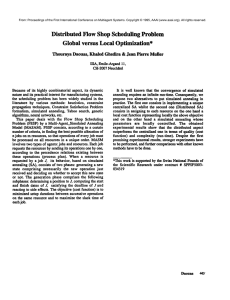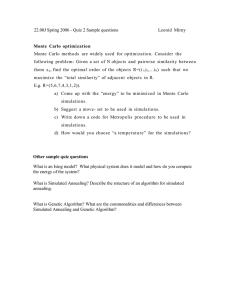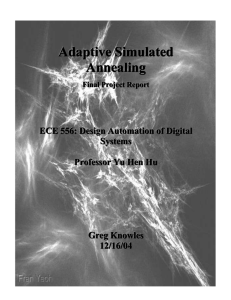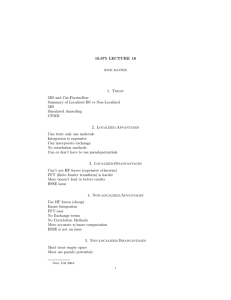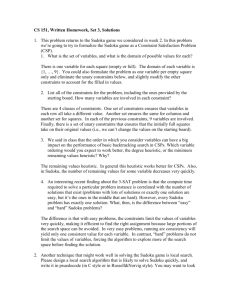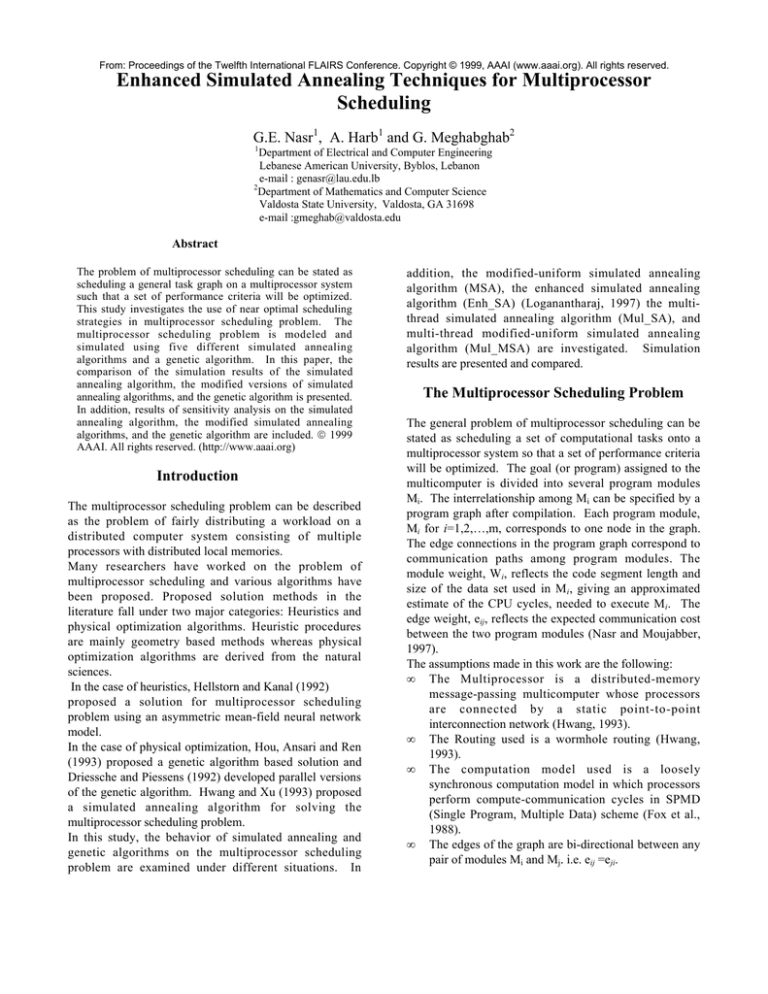
From: Proceedings of the Twelfth International FLAIRS Conference. Copyright © 1999, AAAI (www.aaai.org). All rights reserved.
Enhanced Simulated Annealing Techniques for Multiprocessor
Scheduling
G.E. Nasr1, A. Harb1 and G. Meghabghab2
1
Department of Electrical and Computer Engineering
Lebanese American University, Byblos, Lebanon
e-mailÊ: genasr@lau.edu.lb
2
Department of Mathematics and Computer Science
Valdosta State University, Valdosta, GA 31698
e-mailÊ:gmeghab@valdosta.edu
Abstract
The problem of multiprocessor scheduling can be stated as
scheduling a general task graph on a multiprocessor system
such that a set of performance criteria will be optimized.
This study investigates the use of near optimal scheduling
strategies in multiprocessor scheduling problem. The
multiprocessor scheduling problem is modeled and
simulated using five different simulated annealing
algorithms and a genetic algorithm. In this paper, the
comparison of the simulation results of the simulated
annealing algorithm, the modified versions of simulated
annealing algorithms, and the genetic algorithm is presented.
In addition, results of sensitivity analysis on the simulated
annealing algorithm, the modified simulated annealing
algorithms, and the genetic algorithm are included. 1999
AAAI. All rights reserved. (http://www.aaai.org)
Introduction
The multiprocessor scheduling problem can be described
as the problem of fairly distributing a workload on a
distributed computer system consisting of multiple
processors with distributed local memories.
Many researchers have worked on the problem of
multiprocessor scheduling and various algorithms have
been proposed. Proposed solution methods in the
literature fall under two major categories: Heuristics and
physical optimization algorithms. Heuristic procedures
are mainly geometry based methods whereas physical
optimization algorithms are derived from the natural
sciences.
In the case of heuristics, Hellstorn and Kanal (1992)
proposed a solution for multiprocessor scheduling
problem using an asymmetric mean-field neural network
model.
In the case of physical optimization, Hou, Ansari and Ren
(1993) proposed a genetic algorithm based solution and
Driessche and Piessens (1992) developed parallel versions
of the genetic algorithm. Hwang and Xu (1993) proposed
a simulated annealing algorithm for solving the
multiprocessor scheduling problem.
In this study, the behavior of simulated annealing and
genetic algorithms on the multiprocessor scheduling
problem are examined under different situations. In
addition, the modified-uniform simulated annealing
algorithm (MSA), the enhanced simulated annealing
algorithm (Enh_SA) (Loganantharaj, 1997) the multithread simulated annealing algorithm (Mul_SA), and
multi-thread modified-uniform simulated annealing
algorithm (Mul_MSA) are investigated. Simulation
results are presented and compared.
The Multiprocessor Scheduling Problem
The general problem of multiprocessor scheduling can be
stated as scheduling a set of computational tasks onto a
multiprocessor system so that a set of performance criteria
will be optimized. The goal (or program) assigned to the
multicomputer is divided into several program modules
Mi. The interrelationship among Mi can be specified by a
program graph after compilation. Each program module,
Mi for i=1,2,É,m, corresponds to one node in the graph.
The edge connections in the program graph correspond to
communication paths among program modules. The
module weight, Wi, reflects the code segment length and
size of the data set used in Mi, giving an approximated
estimate of the CPU cycles, needed to execute Mi. The
edge weight, eij, reflects the expected communication cost
between the two program modules (Nasr and Moujabber,
1997).
The assumptions made in this work are the following:
• The Multiprocessor is a distributed-memory
message-passing multicomputer whose processors
are connected by a static point-to-point
interconnection network (Hwang, 1993).
• The Routing used is a wormhole routing (Hwang,
1993).
• The computation model used is a loosely
synchronous computation model in which processors
perform compute-communication cycles in SPMD
(Single Program, Multiple Data) scheme (Fox et al.,
1988).
• The edges of the graph are bi-directional between any
pair of modules Mi and Mj. i.e. eij =eji.
•
•
Bi-directional links are assumed between all pairs of
computer nodes in a multicomputer.
The distance between any two computer nodes is
defined as the number of hops between them.
The Objective Function
The job of the objective function is to be a guide for the
algorithm to achieve optimization (minimizing system
execution time in the case of load balancing). In this
study a system oriented objective function (OFso) is used.
This cost function is defined as OFso = Eimb + Ecom ,
where Eimb is the system load imbalance and Ecom is the
communication cost (Nasr and Moujabber, 1997).
For a given load distribution, an imbalance vector is
defined ∆=(δ1,δ2,δ3,É,δn) over n computer nodes, where
the load offset δi for the node Ci is defined as δi = |li - L|
and L is the load average among n computer nodes (Total
load/n). The system load imbalance is defined by:
Eimb = ∑δi. The communication cost is the sum of the
matrix expressed as Ecom = 1/2 ∑[∑Cij] & Cij = dij ∑[∑exy],
where dij is the distance between the nodes and exy is the
edge weight between all program modules Mx in Ci and
My in Cj.
Scheduling Methods
Simulated Annealing Algorithm (SA)
SA is a physical optimization technique which accepts a
bad criteria in order to reach a global minimum (or
optimal solution).
SA starts with a randomly generated initial solution. In
each iteration, the solution is randomly perturbed. If such
a perturbation results in negative or zero change in the
system energy, then it is accepted. To prevent premature
convergence when trapped in a bad optimum, the
simulated annealing accepts positive changes in energy
with a certain temperature dependent probability.
In order to apply the simulated annealing algorithm for
solving the multiprocessor scheduling problem the
following steps are followed:
1. Give an initial value for the temperature T and assign
a constant value for K (cooling schedule).
2 . Distribute the jobs (tasks) on the processors
randomly.
3. Evaluate the system weight, for this initial random
generation, using the objective function OFso.
4. Select two processors a and b, randomly (the selected
processes a and b must be different). Then select
(also randomly) two tasks, one from a and another
one from b.
5. Swap the selected tasks between the two processors a
and b.
6 . Evaluate again the system weight, for this
perturbation, using the objective function OFso.
7. If the new system weight is smaller than the previous
one, accept this new state and use it as a new starting
point for the next perturbation.
8. If not, generate a random number, RND, between 0
and 1. If
RND< e[[Previous system weight - new system weight]/T],
accept the situation and use it as a new starting point
for the next perturbation. If not, reject and keep the
previous one as the starting point for the next
perturbation.
9. Repeat the steps starting from part 4 for n successive
rejections (in this study n = 3).
10. Change the temperature T as follows: T = T * K.
11. Repeat the steps starting from part 4 for a new
temperature until the temperature becomes less or
equal to 1.
The value of the cooling factor is problem-dependent and
has to be determined experimentally.
Enhanced Simulated Annealing Algorithm
(Enh_SA)
It is clear that the SA technique achieves better solution
than a local search method by incorporating a chance for
accepting higher cost, or letting the algorithm to jump
some short distance subject to some pre-set parameters (k,
p, and temperature). The enhanced annealing technique
draws parallel from selecting different solid samples at
different energy levels, and heating each sample to a
higher temperature and then cooling it down till it reaches
the lowest energy equilibrium. The cooled down sample
with the lowest energy level provides the solution
(Loganantharaj, 1997).
In order to apply the enhanced simulated annealing
algorithm for solving the multiprocessor scheduling
problem the following steps are followed:
1. Distribute the jobs (tasks) on the processors randomly
and evaluate the system weight (using the OFso) for
100 times.
2 . Find the mean of 100 system weights, which are
found in part 1.
3 . Select a threshold percentage such that any case
having a system weight greater than 20% above the
mean is selected as a seed to perform multi-thread
annealing.
4. Collect enough number of seeds.
5. Apply the simulated annealing algorithm as discussed
before for every seed.
6. Select the distribution that has the minimum system
weight.
Multi-Thread Simulated Annealing Algorithm
(Mul_SA)
The enhanced simulated annealing algorithm is
reexamined under new seed selection criteria. The
following modifications are adopted:
1. select the seeds randomly.
2. Reapply on the selected seed the simulated annealing
algorithm.
3. Select the distribution that has the smallest system
weight as a solution.
Modified-Uniform Simulated Annealing
Algorithm (MSA)
As a variation on the simulated annealing algorithm, the
Boltzman function in the simulated annealing algorithm is
replaced by a uniform function. The modifications on the
simulated annealing algorithm are done by replacing the
Boltzman function in step 8 of SA by a uniform function
and deleting steps 10 and 11 of the same algorithm.
Multi-Thread Modified-Uniform Simulated
Annealing Algorithm (Mul_MSA)
This algorithm draws parallel from selecting different
samples. So, instead of taking one seed and applying on
it the modified-uniform simulated annealing algorithm
(MSA), many seeds are selected for the application of
MSA.
Genetic Algorithm (GA)
Genetic algorithms are search algorithms based on the
mechanics of natural selection and natural genetics
(Holland, 1975).
A genetic algorithm consists of the following steps:
1 . Initialization: an initial population of the search
nodes is randomly generated.
2. Evaluation of the fitness function: the fitness value of
each node is calculated according to the fitness
function or objective function.
3. Genetic operations: new search nodes are generated
randomly by examining the fitness value of the
search nodes and applying the genetic operators to
the search nodes.
Repeat steps 2 and 3 until the algorithm converges.
GA is composed of three operators:
1 . Reproduction: Reproduction is a process in which
individual strings are copied according to their fitness
function values. The fitness function is evaluated for
all populations. The population which has the
minimum fitness value is replaced by the one which
has the maximum value.
2 . Crossover: crossover may proceed in three steps.
First, two random strings are chosen for the crossover
procedure. Second, a random number k is generated
with a value between 1 and the string length minus 1,
[1,l-1]. In our case, k is generated with a value
between the lowest and the highest task weight.
Finally, two new strings are created by swapping all
characters between position k + 1 and l inclusively.
3. Mutation: first, select randomly two processors a and
b from one population. Second, select randomly 2
tasks, one from processor a and the other from
processor b. Finally, swap these two selected tasks
between the processors a and b.
The number of mutations depends on the mutation
probability ρ defined by:
number of mutations = ρ * number of processor * number
of tasks.
Simulation Results
Various tests are performed to evaluate and compare the
performance of the above mentioned algorithms. The
tests were conducted on 2 task graphs. These graphs were
randomly generated. The first one was a graph of 32 jobs
and the second one was a 64-jobs graph. Algorithm
performances on the two graphs were studied using six
different topologies. These topologies were 16-nodes
Hypercube, 8-nodes Hypercube, 16-nodes Ring and 8nodes Ring.
Algorithm performances are studied in terms of two
measures. The first measure is the solution quality
(Optimizing the system objective function OFso) and the
second measure is the execution time measured in unit of
time. The results for each test are quoted in terms of the
system weight, the time and the percentage enhancement
with respect to the initial random distribution. In
addition, the comparison between the means of the data
using hypothesis testing and confidence interval analysis
is performed (Douglas, 1996). All simulations are
performed using Mathematica software. The parameters
used in the simulations are listed below.
• The cooling factor K = 0.75 and the initial
temperature T = 50 in the simulation of SA.
• The percentage range r = 0.03 in the simulation of
MSA.
• A population size of 16 and a mutation probability ρ
= 0.0005 in the simulation of GA.
• For the Enh_SA, a seed is accepted for the
reapplication of SA if it falls above 20% of the
system weight mean.
• For Mul_SA, 10 seeds are randomly selected for the
reapplication of SA.
• For Mul_MSA, 10 seeds are randomly selected for
the reapplication of MSA.
The following graphs show the simulation results of the
mean of 20 multiprocessor scheduling tests using the
above mentioned algorithms to distribute 64 jobs on 8
processors.
The comparison of simulation results provides the
following observations.
•
Mean
2 00 0
The system weight enhancement (for all kinds of
topologies) using all the discussed algorithms
follows the below equation under hypothesis testing.
µ[Enhancement(Mul_MSA)]>µ[Enhancement (MSA)] ≥
µ [Enhancement(Mul_SA)]=µ [Enhancement(Enh_SA)]>
µ [Enhancement(SA)] > µ [Enhancement(GA)]
1 80 0
1 60 0
1 40 0
1 20 0
Cube
1 00 0
•
Ring
80 0
60 0
•
40 0
20 0
0
Initial
Weig ht
Init ial GA
SA
GA
Enh_SA
Mul_SA
MSA
Mul_MSA
The same enhancement is obtained for Enh_SA and
Mul_SA.
The improvement, in minimizing the objective
function OFso, using MSA, SA, and GA follows the
following equation:
A l gor i thms
Improvement of MSA > Improvement of SA >
Improvement of GA.
Fig. 1. The mean of the system weight
On the other hand, the execution time of MSA, SA, and
GA follows the following equation:
Mean
140
Execution time of MSA > Execution time of SA
> Execution time of GA.
120
100
80
Cube
Rin g
60
40
20
0
SA
GA
Enh_SA
Mul_ SA
MSA
In addition, sensitivity analysis for SA with respect to its
cooling factor, MSA with respect to its percentage range,
and GA with respect to its population size and mutation
probability are considered. The sensitivity analysis
revealed the following:
Mul_MSA
•
A l g o ri th ms
Fig. 2. The execution time mean
Mean
•
90
80
Percentage
70
•
60
50
Cube
40
Ring
30
SA is sensitive to the variation of the cooling factor.
When the cooling factor increases, the enhancement
from the initial system weight and the execution time
also increase.
MSA is sensitive to the variation of the percentage
range. In particular, when the percentage range
increases the enhancement from the initial system
weight decreases and the execution time increases.
A moderate mutation probability (0.0005) gives a
better improvement than the lowest (0.00005) and the
highest (0.005) mutation probabilities. In addition,
GA appears not to be sensitive to the population size.
20
10
0
SA
GA
Enh_SA
Mul_SA
MSA
Mul_MSA
Conclusion
Algorithms
Fig. 3. Percentage enhancement from the initial system
weight
In this paper, the behavior of simulated annealing and
genetic algorithm on the multiprocessor scheduling
problem are examined under different situations. In
addition, the modified-uniform simulated annealing
algorithm (MSA), the enhanced simulated annealing
algorithm (Enh_SA), the multi-thread simulated annealing
algorithm (Mul_SA), and multi-thread modified-uniform
simulated annealing algorithm (Mul_MSA) are
investigated. The simulation results presented in this
paper showed that Mul_MSA provides more system
weight enhancement than the other methods and that the
same enhancement can be obtained when using either
Enh_SA or Mul_SA. In addition, the enhancement from
the initial system weight and the execution time were
found to increase with the increase of the cooling factor
for the simulated annealing algorithm. However, the
enhancement from the initial system weight was found to
decrease with the increase of the percentage range in the
case of MSA. It should also be noted that no conclusive
data was obtained to formulate a comparative statement
on the execution time of the different algorithms.
References
Douglas, C., 1996, Design and Analysis of Experiments,
John Wiley & Sons, Inc.
Fox, G. C., Johnson ,M., Lyzenga, G., Otto, S., Slamon,
J., Walker, D., 1988, Solving Problems on Concurrent
Processors, Englewood Cliffs, N, J, Prentice-Hall.
Helstron, B. and Kanal, L., 1992 Asymmetric Mean Field
Neural Networks for Multiprocessor Scheduling, Neural
Networks, 5, 671-686.
Holland, J., 1975, Adaptation in Natural and Artificial
Systems, University of Michigan press.
Hou, E., Ansari, N. and Hong, R., 1993 A Genetic
Algorithm for Multiprocessor Scheduling, IEEE
Transactions on parallel and Distributed Systems, 4 (1):
121-134.
Hwang, K. and Xu, J., 1993, Mapping Partitioned
Program Modules onto Multicomputer Nodes Using
Simulated Annealing, Int. Conf. Parallel Processing, 2,
292-293.
Hwang, K., 1993, Advanced Computer Architecture:
Parallelism, Scalability, Programmability, McGraw-Hill,
Singapore.
Loganantharaj, R., 1997, A Method to Enhance A
Simulated Annealing Technique, Proc. of the 10th Florida
Artificial Intelligence Research Symposium, 217-221.
Nasr, G. E. and Moujabber, B. N., 1997, A New
Deterministic Technique for Multiprocessor Scheduling,
Proc. of 2 nd LAAS International Conferences on
Computer Simulation,. 117-122.
Van Driessche, R. and Piessens, R., 1992, Load Balancing
with Genetic Algorithm, Parallel Solving from Nature, 2,
Brussels, Belgium.

